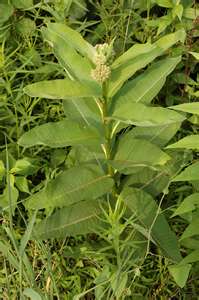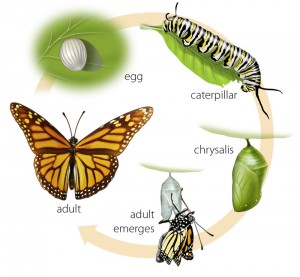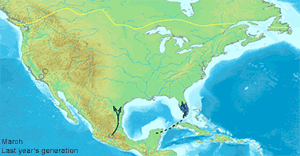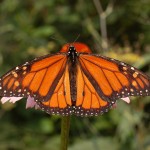- Female Monarch Butterfly
- Monarch Caterpillar Feeding
- Male Monarch Butterfly
Have you seen any Monarchs this year in Pennsylvania? Probably not. The Monarch population is decreasing at an alarming rate! Why?
 Monarch butterflies need nectar from flowers and the Monarch larva (caterpillar) only eats milkweed. Unfortunately 90% of milkweed and Monarch habitat occurs within agricultural areas and these areas are disappearing due to development. The use of herbicides is another contributing factor to disappearing habitat. The use of herbicides in farming is eradicating the milkweed because milkweed is poisonous and farmers do not want it in their fields. A milkweed plant bound in a bale of hay or eaten by a grazing cow can result in disastrous consequences. The poison, however, is beneficial to the Monarch. The Monarch’s bright orange color warns birds that it is poisonous. The caterpillar only ingests milkweed, consequently during the final stage the butterfly is poisonous. The milkweed plant also grows frequently along roadsides where herbicide sprays and cutting are used to kill roadside growth. Weather has also been unkind to the Monarchs. Migration, life cycle stages, and winter habitat are influenced by weather conditions. The 4th generation of Monarchs migrate from Pennsylvania to the mountaintops of the Oyamel fir forests in Central Mexico. Last winter in Central Mexico was unusually cold causing many fatalities which means less Monarchs to carry on the next generation.
Monarch butterflies need nectar from flowers and the Monarch larva (caterpillar) only eats milkweed. Unfortunately 90% of milkweed and Monarch habitat occurs within agricultural areas and these areas are disappearing due to development. The use of herbicides is another contributing factor to disappearing habitat. The use of herbicides in farming is eradicating the milkweed because milkweed is poisonous and farmers do not want it in their fields. A milkweed plant bound in a bale of hay or eaten by a grazing cow can result in disastrous consequences. The poison, however, is beneficial to the Monarch. The Monarch’s bright orange color warns birds that it is poisonous. The caterpillar only ingests milkweed, consequently during the final stage the butterfly is poisonous. The milkweed plant also grows frequently along roadsides where herbicide sprays and cutting are used to kill roadside growth. Weather has also been unkind to the Monarchs. Migration, life cycle stages, and winter habitat are influenced by weather conditions. The 4th generation of Monarchs migrate from Pennsylvania to the mountaintops of the Oyamel fir forests in Central Mexico. Last winter in Central Mexico was unusually cold causing many fatalities which means less Monarchs to carry on the next generation.
 The Monarch goes through 4 stages in its life cycle. The female butterfly will lay about 500 eggs laying a single egg (stage one) on the underside of a milkweed leaf, 1 egg to each plant. (The male Monarch can be differentiated from the female by 2 black dots on the left and right back of the lower wings.) In about four days the egg will hatch entering stage 2, the larva or caterpillar. The caterpillar or first instar larva, will eat its egg shell and begin eating the hairs and leaf of milkweed plant leaving a small arch shaped hole in the leaf. As the caterpillar gets larger it will make a circular hole in the leaf. Each time the caterpillar sheds its skin it is called an instar. In the 4th instar the caterpillar has very distinct yellow, white, and black bands. The caterpillar will go through 5 instars before entering the 3rd stage of the cycle, the pupa or chrysalis. The caterpillar will attach itself to a leaf, twig, or other chosen spot hanging upside down. It will curve and take a J shape, jiggling, squirming, and curling up until its skin splits revealing the pupa or chrysalis. The chrysalis when first formed is soft and pale yellow-bluish green with some yellow spots. Once the chrysalis hardens it becomes a green color and the spots turn to gold. In 7 to 15 days the chrysalis will darken and the butterfly (stage 4) can be seen within. The chrysalis will split, typically in the morning, and the butterfly will emerge. The wings will be wet and crumpled. DO NOT touch a Monarch in this condition or the wings will be harmed. The butterfly will squeeze its abdomen up and down pumping fluids through its veins in the wings. In a couple of hours the wings will dry and be hard enough for the butterfly to fly. This completes the 4 stages in the life cycle of a Monarch butterfly.
The Monarch goes through 4 stages in its life cycle. The female butterfly will lay about 500 eggs laying a single egg (stage one) on the underside of a milkweed leaf, 1 egg to each plant. (The male Monarch can be differentiated from the female by 2 black dots on the left and right back of the lower wings.) In about four days the egg will hatch entering stage 2, the larva or caterpillar. The caterpillar or first instar larva, will eat its egg shell and begin eating the hairs and leaf of milkweed plant leaving a small arch shaped hole in the leaf. As the caterpillar gets larger it will make a circular hole in the leaf. Each time the caterpillar sheds its skin it is called an instar. In the 4th instar the caterpillar has very distinct yellow, white, and black bands. The caterpillar will go through 5 instars before entering the 3rd stage of the cycle, the pupa or chrysalis. The caterpillar will attach itself to a leaf, twig, or other chosen spot hanging upside down. It will curve and take a J shape, jiggling, squirming, and curling up until its skin splits revealing the pupa or chrysalis. The chrysalis when first formed is soft and pale yellow-bluish green with some yellow spots. Once the chrysalis hardens it becomes a green color and the spots turn to gold. In 7 to 15 days the chrysalis will darken and the butterfly (stage 4) can be seen within. The chrysalis will split, typically in the morning, and the butterfly will emerge. The wings will be wet and crumpled. DO NOT touch a Monarch in this condition or the wings will be harmed. The butterfly will squeeze its abdomen up and down pumping fluids through its veins in the wings. In a couple of hours the wings will dry and be hard enough for the butterfly to fly. This completes the 4 stages in the life cycle of a Monarch butterfly.
 It takes 4 generations of Monarchs to reach Pennsylvania from Central Mexico, with the 4th generation hatching in Pennsylvania and emerging as adults in late August. It is the fourth generation that migrates and lives the longest, up to 9 months, while other generations only live a few weeks. The fourth generation does not mature sexually until the spring after wintering in Mexico. As they migrate this generation will meet with other migrating monarchs eating a lot of nectar along the way to fatten up for the winter ahead. By November the 4th generation reaches the mountaintops of Central Mexico and roosts on the Oyamel fir trees, moving occasionally for a drink of water. Otherwise they remain on the trees throughout the winter. In spring (mid March) they begin mating as they start their migration north and east. They lay their eggs from late March through April in the southern United States and northern Mexico. These eggs hatch and the 1st generation is started. Since it is often cool when the 1st generation is developing it may take them up to 40 or 50 days, or even more, to develop from eggs to adults. The 1st generation adults mate and lay eggs as they migrate north arriving in the northern US and southern Canada in late May. The 2nd generation eggs are laid throughout much of North America and are widely distributed throughout the eastern United States. Adults emerge in June and July mating and laying eggs soon after emerging as they continue to migrate north. Generation three and four are laid throughout the northern part of the range of eastern migratory monarchs from late May through July (Generation 3), and late June through August (Generation 4).
It takes 4 generations of Monarchs to reach Pennsylvania from Central Mexico, with the 4th generation hatching in Pennsylvania and emerging as adults in late August. It is the fourth generation that migrates and lives the longest, up to 9 months, while other generations only live a few weeks. The fourth generation does not mature sexually until the spring after wintering in Mexico. As they migrate this generation will meet with other migrating monarchs eating a lot of nectar along the way to fatten up for the winter ahead. By November the 4th generation reaches the mountaintops of Central Mexico and roosts on the Oyamel fir trees, moving occasionally for a drink of water. Otherwise they remain on the trees throughout the winter. In spring (mid March) they begin mating as they start their migration north and east. They lay their eggs from late March through April in the southern United States and northern Mexico. These eggs hatch and the 1st generation is started. Since it is often cool when the 1st generation is developing it may take them up to 40 or 50 days, or even more, to develop from eggs to adults. The 1st generation adults mate and lay eggs as they migrate north arriving in the northern US and southern Canada in late May. The 2nd generation eggs are laid throughout much of North America and are widely distributed throughout the eastern United States. Adults emerge in June and July mating and laying eggs soon after emerging as they continue to migrate north. Generation three and four are laid throughout the northern part of the range of eastern migratory monarchs from late May through July (Generation 3), and late June through August (Generation 4).
How can you help increase the Monarch population? Contact Monarch Watch. Monarchs need resource patches or Monarch Waystations in home gardens, parks, nature centers, along roadsides, and on other unused plots of land. These Waystations should have milkweed, nectar sources and shelter. Complete, up-to-date information about Monarch Watch’s Monarch Waystation program is available online. Create a waystation and help out the Monarchs!




hello! Great article. We raise and tag Monarchs each fall. What a great experience! This year our 4th grade daughter performed a comparison experiment to find out whether Monarchs have a higher rate of reaching adulthood if raised in captivity from egg vs. caterpillar. She had a great time with this project. She is working on her science fair board and would like to put a picture of the Monarch life cycle. Would you be willing to grant her permission to use the cycle you have posted in your article?
Thank you for your time!
Rebekah